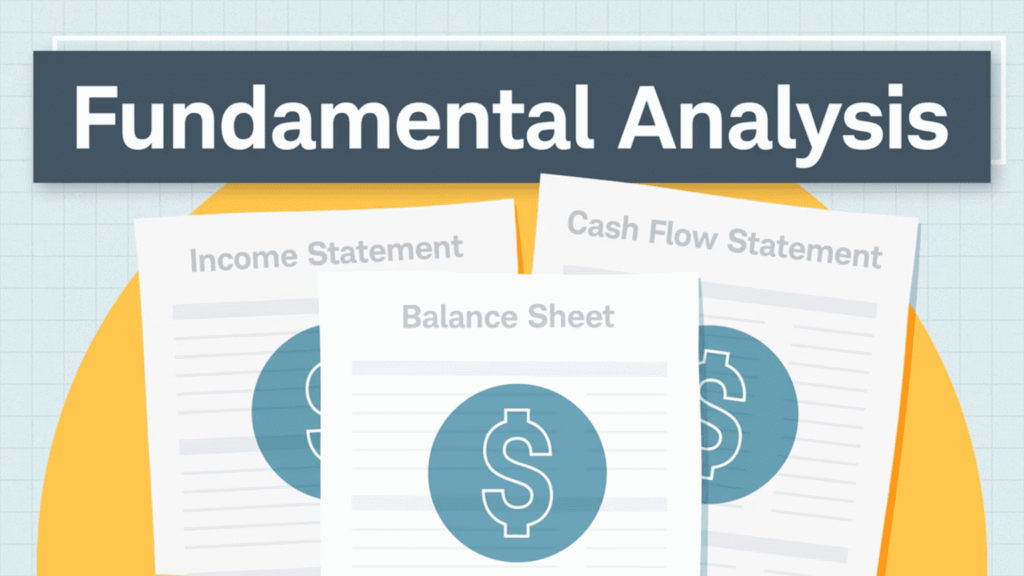If you’re new to stock investing, you may wonder how to pick the right stocks. One of the best ways to evaluate a stock is through fundamental analysis. This method helps you understand the true value of a company by looking at its financial health, management, and industry position. Unlike technical analysis, which focuses on stock price movements and charts, fundamental analysis examines the company’s overall business strength. This guide will break down the key steps in an easy-to-understand way, so you can start making informed investment decisions.
What is Fundamental Analysis?
Fundamental analysis is a way to determine whether a stock is a good investment by checking the company’s financial reports, competitive position, and industry trends. Investors use fundamental analysis to find stocks that are undervalued (priced lower than their true worth) or to avoid stocks that are overvalued. Fundamental analysis – method is ideal for long-term investors
Key Components of Fundamental Analysis

To analyse a stock properly, you need to look at two main factors:
Financial Health (Numbers & Reports): Companies publish financial statements to show how they are performing. The three most important reports are:
- Income Statement (Profit & Loss Report)
- Shows how much money a company earns and spends for a period.
- Example: Suppose you are analysing Apple Inc. (AAPL). In 2023, Apple reported $394 billion in revenue and $99.8 billion in net income. This shows the company is highly profitable.
- Balance Sheet (What the Company Owns & Owes)
- Provides a summary of a company’s financial position at a specific time.
- Example: Tesla (TSLA) had around $29.1 billion in cash and cash equivalents in 2023. However, it also had debts, and checking its Debt-to-Equity Ratio can help determine its financial stability.
- Cash Flow Statement (Company’s Cash Movement)
- Shows how much actual cash the company is generating in particular period.
- Example: Amazon (AMZN) had a free cash flow of $21.4 billion in 2023, indicating strong liquidity.
Business Strength & Market Position (Non-Financial Factors): Numbers don’t tell the full story. You should also check:
- Business Model & Competitive Edge
- Example: Coca-Cola (KO) has a strong brand and a global distribution network, making it a market leader in the beverage industry.
- Management & Leadership
- Example: Microsoft (MSFT) has had strong leadership under Satya Nadella, leading to significant growth in cloud computing and software services.
- Industry & Growth Trends
- Example: The electric vehicle industry is growing rapidly, making companies like Tesla (TSLA) attractive for long-term investors.
- Economic & Market Conditions
- Example: During an economic downturn, consumer spending may drop, affecting companies like Nike (NKE) that rely on discretionary spending.
Key Ratios Used in Fundamental Analysis
Ratios help you quickly understand a company’s financial condition. While doing fundamental analysis these ratios are more important. Here are the most useful ones:
- Price-to-Earnings Ratio (P/E)
- Definition: Measures how much investors are willing to pay per dollar of earnings.
- Formula: P/E = Stock Price / Earnings Per Share (EPS)
- Example: If Google (GOOGL) has a P/E ratio of 25, it means investors are willing to pay 25 times its earnings for its stock.
- Price-to-Book Ratio (P/B)
- Definition: Compares a company’s market price to its book value (net assets).
- Formula: P/B = Stock Price / Book Value Per Share
- Example: A P/B ratio of below 1 (like some banking stocks) may indicate an undervalued stock.
- Return on Equity (ROE)
- Definition: Measures how efficiently a company generates profits from shareholders’ equity.
- Formula: ROE = Net Profit / Shareholders’ Equity
- Example: A company like Apple (AAPL) with a high ROE of 40% means it efficiently generates profit from shareholders’ investments.
- Dividend Yield
- Definition: Shows the percentage of a company’s stock price that is paid out as dividends.
- Formula: Dividend Yield = Annual Dividend / Stock Price
- Example: Johnson & Johnson (JNJ) has a stable dividend yield of around 2.8%, making it attractive for income investors.
- Debt-to-Equity Ratio (D/E)
- Definition: Measures a company’s financial leverage and reliance on debt.
- Formula: D/E = Total Debt / Shareholders’ Equity
- Example: A company like Netflix (NFLX) has a high D/E ratio, indicating it uses significant debt to fund operations.
How to Analyse a Stock Step by Step
Step 1: Understand the Company: Read about the company’s business and how it makes money. Example: Apple (AAPL) makes money from iPhones, services, and wearables.
Step 2: Review Financial Statements: Look at the income statement, balance sheet, and cash flow statement. Example: Amazon (AMZN) has strong cash flows but reinvests heavily in expansion.
Step 3: Compare with Competitors: Example – Compare Google (GOOGL) with Microsoft (MSFT) in the cloud computing sector.
Step 4: Check for Growth Potential: Example – Nvidia (NVDA) is growing due to high demand for AI chips.
Step 5: Identify Risks: Example – Airlines like Delta (DAL) face risks from fuel prices and travel demand fluctuations.
Step 6: Estimate Fair Value
- Use valuation methods like P/E ratio and discounted cash flow (DCF) analysis.
- Example: If Tesla’s fair value is $180 per share, but it trades at $250, it might be overvalued.
Step 7: Make Your Investment Decision
- Example: If Microsoft (MSFT) has consistent growth, low debt, and high profit margins, it could be a strong investment.
Common Mistakes to Avoid
Here’s a brief explanation of the common mistakes to avoid while doing fundamental analysis:
- Ignoring Debt Levels – A company may appear profitable, but excessive debt can make it risky. Always check the Debt-to-Equity Ratio to ensure the company isn’t overleveraged.
- Relying on One Ratio Only – No single financial ratio gives the full picture. A low P/E ratio might indicate an undervalued stock, but if the company has high debt or declining sales, it could still be a bad investment.
- Ignoring Industry Trends – Even a financially strong company can struggle if its industry is declining. For example, Kodak failed because it didn’t adapt to the shift from film to digital photography.
- Following Hype Instead of Research – Investing based on trends, media hype, or social media can be dangerous. Stocks like GameStop (GME) saw huge surges but also sharp crashes, leaving uninformed investors with losses.
- Not Monitoring Investments Regularly – Companies evolve, and economic conditions change. Regularly reviewing financial reports and industry news ensures you stay informed about your investments.
Conclusion
Fundamental analysis is a valuable skill for stock investors. By understanding financial statements, business models, and industry trends, you can make informed investment decisions.
If you’re just starting, begin by analysing well-known companies with strong financials. Use websites like Yahoo Finance, Bloomberg, or company reports to gather information.
With time and practice, you’ll become more confident in selecting the right stocks for long-term success.
Disclaimer
The content on this platform is for informational and educational purposes only and should not be considered financial, investment, or legal advice. While we strive to provide accurate and up-to-date information, we do not guarantee the completeness, reliability, or suitability of the information provided.















